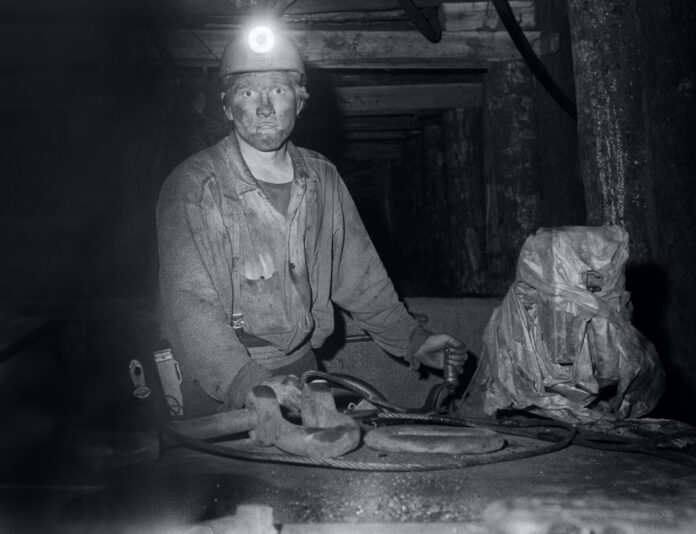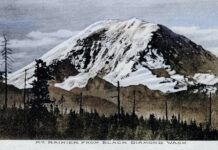Over the years this column has featured more than 25 photos taken by Barry Kombol. This is the story of how that collection of photos came to exist, so it’s only fitting to feature one of the pictures he took of himself.
In late April 1974, Barry Kombol was working at Rogers No. 3 coal mine in Ravensdale. A year earlier he graduated from the University of Washington with a degree in History. During his junior year, Kombol took a class in photography, joined the photography club, and purchased a Minolta SRT-101 camera with a 50-millimeter lens.
The Rogers No. 3 mine was nearing the end of an era that began in 1958. The mine was unique because the coal seam was tilted nearly vertical due to the uplift of the Cascade Mountains over the past six million years. Kombol marveled at the extraction processes employed by the men who worked the mines. He wanted to capture on film how these miners tunneled deep underground and removed hundreds of tons of coal most days. Rogers No. 3 was the last underground mine in Washington and with its closure the story of their singular techniques and systems used there would be lost.
Almost all the men he worked with were in their late 50s or early 60s and had been mining coal most of their lives. Many worked for Palmer Coking Coal Co., the mine’s owner for decades. Palmer’s management was sympathetic to their employee’s desire to continue working until eligible for union pensions and Social Security. Toward that end, the older miners were all required to obtain physicals, and their doctors found them fit as a fiddle.
The following miners were featured among Kombol’s 200 photos: Tony Basselli, John Costanich, Roy Darby, Archie Eltz, Frank Manowski, Lew McCauley, Bill McLoughry, Joe Ozbolt, George Savicke, Bud Simmons, John Streepy, as well as himself plus two relatives in their 20s, Bill Kombol and Bob Morris, who as part of the company joined the effort after a number of older union miners retired. Even Pee Wee the mine dog was captured on film.
On three days, April 22, 24, and 25, 1974, Kombol worked his normal 8-hour shift taking photos during idle times, then stayed on for the cross-shift. At the time he was living in Seattle’s Capitol Hill neighborhood and commuting to and from Ravensdale. With his Minolta camera he captured the intricacies of simple mining tasks, like replacing a set of timbers, riding a coal car, operating the hoist, drilling coal, wiring dynamite blasts, using a come-along, and filling dummy bags, among others. Capturing good images with 100-speed film in tight spaces and dark tunnels 600 feet underground wasn’t easy. Using flash, he needed to find the proper distance, lest the subject appear washed out or too dark.
In this self-portrait photo, Kombol is operating an electric motor called a trolley that ran on rails and pulled 5-ton metal cars from the working face of the mine to the bottom of the slope. From there coal cars were hoisted to the surface for processing. Lacking a tripod, Barry set the camera on a piece of wood. But in the original photo, the entire left side was excessively lit and washed out. Photo enhancements were undertaken by Doug ‘Boomer’ Burnham, a Tahoma High School teacher who used Photoshop to vastly improve this image. Burnham is a photographer who specializes in landscape and sports portraits at: www.BoomersPhotography.com
One month after taking this photo, Barry Kombol married Cathy Elston. A baby girl was born early the next year. In May 1975, he moved his family into the Hiawatha home of his late grandfather, Tony Kombol. After working at the coal mine for nearly two years, Barry enrolled at the University of Puget Sound Law School in Tacoma. Upon earning his degree, Kombol joined a Tacoma firm for a short time then established his own law practice followed by a 43-year career in Black Diamond.
As for the Minolta camera used to take this and so many photos? Several years later, he was vacationing with his family in Lincoln City, Oregon. While walking along Roads End beach, he tried to beat an ocean wave but lost. The camera was ruined in the salty seawater.







